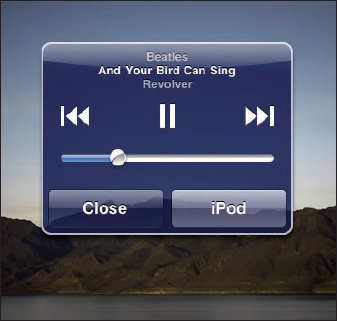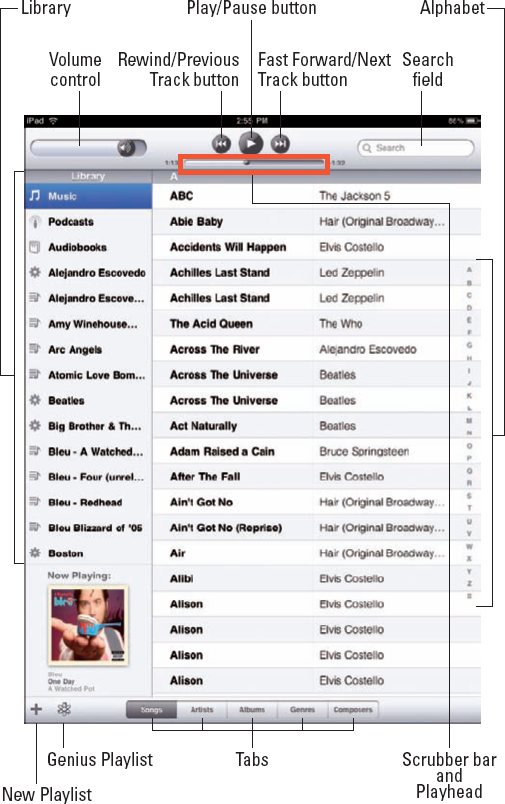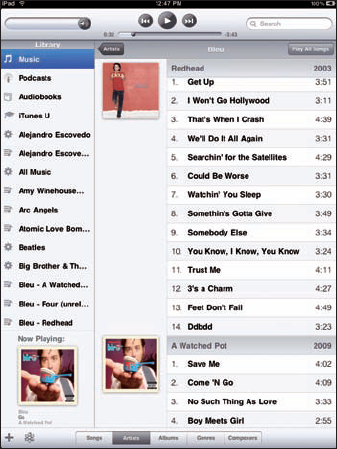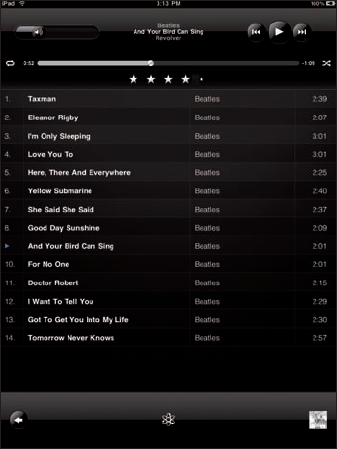In This Chapter
Checking out your iPad's inner iPod
Taking control of your tunes
Customizing your audio experience
Shopping with the iTunes app
Your iPad is perhaps the best iPod ever — especially for working with audio and video. In this chapter, we show you how to use your iPad for audio; in Chapter 9, we cover video.
We start with a quick tour of the iPad's iPod application. Then we look at how to use your iPad as an audio player. After you're nice and comfy with using it this way, we show you how to customize the listening experience so that it's just the way you like it. Then we offer a few tips to help you get the most out of using your iPad as an audio player. Finally, we show you how to use the iTunes application to buy music, audiobooks, videos, and more and how to download free content, such as podcasts.

We assume that you already synced your iPad with your computer and that your iPad contains audio content — songs, podcasts, or audiobooks. If you don't have any audio on your iPad yet, we humbly suggest that you get some (flip to Chapter 3 and follow the instructions) before you read the rest of this chapter — or the next chapter, for that matter.
Okay, now that you have some audio content on your iPad to play with, are you ready to rock?
To use your iPad as an iPod, just tap the iPod icon on the right side of the dock at the bottom of the screen (unless you've moved it elsewhere).
Here's a quick overview of what you see when the iPod app starts up:
Audio library: Along the left side of the screen you'll see your iPad audio library, which contains all the music, podcasts, audiobooks, and playlists you've synced with or purchased on your iPad. For the sake of this demonstration, we're going to ask you to tap on the first item in the library — the one labeled Music — now.
Along the right side of the screen, running from top to bottom, you see the letters of the alphabet from A to Z (unless you're looking at the Genres tab, which doesn't need them). Tap one to jump to that letter instantly when you're browsing Songs, Artists, Albums, or Composers.
Tip
If you don't see the alphabet on the right side of the screen, you either didn't tap Music in the library when we asked you to or you've selected the Genres tab. So tap Music in the library and then tap any tab at the bottom of the screen except Genres, and we'll all be on the same page.
Player controls: At the top of the screen, from left to right, you can see the volume control, the Rewind/Previous Track button, the Play/Pause button, the Fast Forward/Next Track button, and the Search field.
Playlist and tab navigation: At the bottom of the screen, from left to right, you can see a plus sign for adding new playlists, the Genius symbol for creating Genius playlists, and five tabs: Songs, Artists, Albums, Genres, and Composers.
Tip
If you don't see five tabs at the bottom of the screen, chances are you didn't tap Music in the library when we asked you to a few paragraphs back.
We take a closer look at all these features, but for now, Figure 8-1 shows all of them for your enjoyment and edification.
The Music item in your library displays every single song on your iPad. So while the Music item is selected, you can always see every song, artist, album, genre, or composer, depending on the tab you've selected at the bottom of the screen — Songs, Artists, Albums, Genres, or Composers.
Tip
If you don't see every song in your Library, chances are you've typed something into the Search field.
You can find a particular song, artist, album, genre, or composer in several ways.
With the iPod app open, the easiest way to find music is to type a song, artist, album, or composer name into the Search field in the upper-right corner of the screen.
Tip
You can also find songs (or artists, for that matter) without opening the iPod app by typing their names in a Spotlight search, as we mention in Chapter 2.
If you'd rather browse your music library, tap the appropriate tab at the bottom of the screen — Songs, Artists, Albums, Genres, or Composers — and the items of that type appear.
Now you can find a song, artist, album, genre, or composer by
Flicking upward or downward to scroll up and down the list until you find what you're looking for
or
Tapping one of the little letters on the right side of the screen to jump to that letter in the list (all tabs except Genres)
Then, when you find what you're looking for, here's what happens based on which tab is selected:
Songs: The song plays.
Tip
If you're not sure which song you want to listen to, try this: Tap the Shuffle button at the top of the list (just above the first song). Your iPad then plays songs from your music library at random.
Artists: A list of artists' names appears. Tap an artist and all the albums and songs by that artist appear. Tap a song and it plays; tap an album cover and the whole album plays; or tap the Play All Songs button just below the Search field to play all songs from all the albums by that artist. To see the list of artists, you can either tap the Artists button to the right of the word Library at the top of the screen or tap the Artists tab at the bottom of the screen.
Figure 8-2 is what you see after you tap an artist's name (in this case, that artist is Bleu, one of Bob's favorite singer/songwriters).
Albums: Albums works pretty much the same way as artists except you see a grid of album covers instead of a list of artists. Tap an album and its contents appear in an overlay, as shown in Figure 8-3.
To play one of the songs on the album, tap it. To return to the grid of album covers, tap anywhere outside the overlay.
Genres: When you tap the Genres tab, a grid of genres — Comedy, Rock, Pop, Hip Hop/Rap, and so on — appears. Tap a genre and a list of the songs in that genre appears in an overlay.
Tip
If the list of songs in an overlay is longer than the one in Figure 8-3, you may have to flick upward to see the rest of the songs.
Composers: A list of composers appears. Tap a composer and all the albums and songs by that composer appear. Tap a song and it plays; tap an album cover and all the songs from that album play; or tap the Play All Songs button just below the Search field to play all songs from all the albums by that composer. Tap the Composers button near the top of the screen and just to the right of the word Library or tap the Composers tab at the bottom of the screen to return to the list of composers.
One last thing: You won't see any tabs at the bottom of the screen if you select Podcasts, Audiobooks, or iTunes U in the sidebar. These libraries work pretty much the same as we've just described except instead of songs, artists, albums, genres, or composers, you see podcasts, audiobooks, and iTunes U courses.
Now that you have the basics down and can find and play songs (and podcasts, audiobooks, and iTunes U courses), we take a look at some of the things you can do with your iPad when it's in iPod mode.
First things first: We look at the controls you'll use after you tap a song, podcast, audiobook, or iTunes U course. We refer to these things — songs, podcasts, audiobooks, and iTunes U courses — as tracks to avoid confusion (and unnecessary typing).
Tip
Take a peek at Figure 8-1 and you see exactly where all these controls are located on the screen:
Volume control: Drag the little dot left or right to reduce or increase the volume level.
Previous Track/Rewind button: When a track is playing, tap once to go to the beginning of the track or tap twice to go to the start of the preceding track in the list. Touch and hold this button to rewind the track at double speed.
Play/Pause button: Tap to play or pause the track.
Next Track/Fast Forward button: Tap to skip to the next track in the list. Touch and hold this button to fast-forward at double speed.
Tip
You can display playback controls anytime a track is playing. Better still, this trick works even when you're using another application and/or when your iPad is locked: Just double-click the Home button and the controls appear as an overlay, as shown in Figure 8-4.

Figure 8-4. These controls appear — even if you're using another app — when you double-click the Home button while a track is playing.
Warning
The playback control overlay won't appear if you're using an app that has its own audio, like games, apps that record audio, or VOIP (Voice over IP) apps such as Skype.
Scrubber bar and Playhead: Drag the little dot (the playhead) along the Scrubber bar to skip to any point within the track.
Tip
You can adjust the scrub rate by sliding your finger downward on the screen as you drag the playhead along the Scrubber bar. The farther down you slide your finger, the slower the scrub rate. Neat!
But wait, there's more. You see additional controls after you tap the album art in the Now Playing area near the lower-left corner of the screen. Now, tap anywhere on the artwork that fills the screen and several additional controls appear, as shown in Figure 8-5.
Earlier in this section, we explain how to use the Volume control, Rewind/Previous Track button, Play/Pause button, Fast Forward/Next Track button, and Scrubber bar/Playhead. They may look slightly different on this screen, but they work in exactly the same way.
The new controls you see are as follows:
Repeat: Tap once to repeat all songs in the current list (that is, playlist, album, artist, composer, or genre) and play them all over and over. Tap again to repeat the current song again and again. Tap again to turn off repeat.
The button appears in blue after one tap, in blue with a little 1 inside after two taps, and in black and white when repeat is turned off.
Shuffle: Tap this button to play songs at random; tap again to play songs in the order they appear on the screen.
Track List: Tap this button to see all the tracks on the album that contains the song currently playing, as shown in Figure 8-6.
Tap any song on this list to play it. Or, swipe your finger across the dots just beneath the Scrubber bar to rate the song from one to five stars. In Figure 8-6, we've rated the song four stars.
Why would you want to assign star ratings to songs? One reason is that you can use star ratings to filter songs in iTunes on your Mac or PC. Another is that you can use them when you create Smart Playlists in iTunes. And last but not least, they look cool.
Genius: This feature is so cool we devote an entire section to it. See the section "It doesn't take a Genius," later in this chapter.
Back: Tap this button to return to the previous screen.
When what's playing is a podcast or audiobook, you see a somewhat different set of controls when you tap the cover art in the Now Playing area. (If you don't see the controls, tap the cover art to make them reappear.)
We explain the basic controls in the preceding section. The controls that are unique to podcasts and audiobooks, shown in Figure 8-7, are as follows:
E-Mail (podcasts only): Tap this button to send someone an e-mail link to this podcast.
Playback Speed: Tap this button to toggle between normal speed (1X), double speed (2X), or half speed (frac12X).
30-second repeat: Tap this button to hear the last 30 seconds of the podcast or audiobook.
Genius selects songs from your music library that go great together. To use it, tap the Genius button, and your iPad generates a Genius playlist of 25 songs that it picked because it thinks they go well with the song that's playing.
Note
To use the Genius feature on your iPad, you need to turn on Genius in iTunes on your computer and then sync your iPad at least one time.
If you tap the Genius button on the main screen (see Figure 8-1) and no song is currently playing, an alphabetical list of songs appears, and you need to select a song before the Genius playlist can be generated.
When you create a Genius playlist, you'll find an item called Genius in your Library list; tap it and you'll see the 25 songs that Genius selected. You see three buttons in the upper-right corner of the list:
New: Select a different song to use as the basis for a Genius playlist.
Refresh: See a list of 25 different songs that "go great with" the song you're listening to (or song you selected).
Save: Save this Genius playlist so that you can listen to it whenever you like.
When you save a Genius playlist, it inherits the name of the song it's based upon and appears in your library with a Genius icon that looks like the Genius button. And the next time you sync your iPad, the Genius playlist magically appears in iTunes.
Note
The less popular the song, artist, or genre, the more likely the Genius will choke on it. When that happens, you see an alert that asks you to try again because this song doesn't have enough related songs to create a Genius playlist.
Tip
If you like the Genius feature, you can also create a new Genius playlist in iTunes and then sync it with your iPad.
Playlists let you organize songs around a particular theme or mood: operatic arias, romantic ballads, British invasion — whatever. Younger folks sometimes call them mixes.
Your playlists appear in alphabetical order on the left side of the screen, below your music, podcasts, audiobooks, and iTunes U courses. If you don't see Podcasts, Audiobooks, and/or iTunes U in your library, don't worry. That merely means you don't have any podcasts, audiobooks, or iTunes U courses in your iPad's library. And don't worry if you don't have any playlists. Just know that if you had some, you'd see them here.
Although it may be easier to create playlists in iTunes on your computer, your iPad makes it relatively easy to create (and listen to) playlists:
To create a playlist on your iPad, click the New Playlist (+) button (refer to Figure 8-1 for its location). You're asked to name your playlist. Do so and then tap Save. After you do this, you see a list of the songs on your iPad in alphabetical order. Tap the ones you want to have in this playlist and they turn gray, as shown in Figure 8-8. When you've tapped every song you want in the list, tap the Done button just below the Search field.
To listen to a playlist, tap its name in your library and you see a list of the songs it contains. If the list is longer than one screen, flick upward to scroll down. Tap a song in the list and the song will play. When that song is over or you tap the Next Song button, the next song in the playlist will play. This will continue until the last song in the playlist has played, at which point your iPad will shut up.
Note
If your playlist is a Smart Playlist, you can tap Shuffle at the top of the list to hear a song from that playlist (and all subsequent songs) at random. When all songs in the playlist have been played, your iPad will shut up.
Tip
While you can't create Smart Playlists on your iPad, they totally rock. What is a Smart Playlist? Glad you asked. It's a special playlist that selects tracks based on criteria you specify, such as Artist Name, Date Added, Rating, Genre, Year, and many others. Fire up iTunes on your computer and choose File

And that's all there is to selecting, creating, and playing songs in a playlist.
You can tweak volume and equalizer settings to customize your iPad-as-an-iPod experience. If you've noticed and been bothered that the volume of some songs is higher than others, check out the iTunes Sound Check feature. If you want to adjust certain frequencies, the equalizer enables you to do so. And if you want to set a maximum volume limit, tell your iPad to make it so. The following sections explain how.
The iTunes Sound Check option automatically adjusts the level of songs so that they play at the same volume relative to each other. That way, one song never blasts out your ears even if the recording level is much louder than that of the song before or after it. To tell the iPad to use these volume settings, you first have to turn on the feature in iTunes on your computer. Here's how to do that:
Choose iTunes

Click the Playback tab.
Select the Sound Check check box to enable it.
Now you need to tell the iPad to use the Sound Check settings from iTunes. Here's how to do that:
Tap the Settings icon on the iPad's Home screen.
Tap iPod in the list of settings.
Tap the Sound Check On/Off switch so that it says On.
An equalizer increases or decreases the relative levels of specific frequencies to enhance the sound you hear. Some equalizer settings emphasize the bass (low end) notes in a song; other equalizer settings make the higher frequencies more apparent. The iPad has more than a dozen equalizer presets, with names such as Acoustic, Bass Booster, Bass Reducer, Dance, Electronic, Pop, and Rock. Each one is ostensibly tailored to a specific type of music.
The way to find out whether you prefer using equalization is to listen to music while trying out different settings. To do that, first start listening to a song you like. Then, while the song is playing, follow these steps:
Tap the Settings icon on the Home screen.
Tap iPod in the list of settings.
Tap EQ in the list of iPod settings.
Tap different EQ presets (Pop, Rock, R&B, or Dance, for example), and listen carefully to the way they change how the song sounds.
When you find an equalizer preset that you think sounds good, tap the Home button and you're finished.
If you don't like any of the presets, tap Off at the top of the EQ list to turn off the equalizer.
You can instruct your iPad to limit the loudest listening level for audio or video. To do so, here's the drill:
Tap the Settings icon on the Home screen.
Tap iPod in the list of settings.
Tap Volume Limit in the list of iPod settings.
Drag the slider to adjust the maximum volume level to your liking.
(Optional) Tap Lock Volume Limit to assign a four-digit passcode to this setting so that others can't easily change it.
Warning
The Volume Limit setting limits the volume of only music and videos. It doesn't apply to podcasts or audiobooks. And, although the setting works with any headset, headphones, or speakers plugged into the headset jack on your iPad, it doesn't affect sound played on your iPad's internal speaker.
By the way, speaking of that lone internal iPad speaker, it is not in stereo though it sounds pretty good just the same. Of course, when you plug in headphones, you are hearing rich stereo output.
Last but certainly not least, the iTunes application lets you use your iPad to download, buy, or rent just about anything you can download, buy, or rent with the iTunes application on your Mac or PC, including music, audiobooks, iTunes University classes, podcasts, and videos. And, if you're fortunate enough to have an iTunes gift card or gift certificate in hand, you can redeem it directly from your iPad.
If you want to do any of that, however, you must first sign in to your iTunes Store account:
Tap the Settings icon on the Home screen.
Tap Store in the list of settings.
Tap Sign In.
Type your username and password.
Or, in the unlikely event that you don't have an iTunes Store account already:
Tap the Settings icon on the Home screen.
Tap Store in the list of settings.
Tap Create New Account.
Follow the on-screen instructions.
After the iTunes Store knows who you are (and, more importantly, knows your credit card number), tap the iTunes icon on your Home screen and shop until you drop. It works almost exactly the same as the iTunes App Store, which you read about in Chapter 7.








